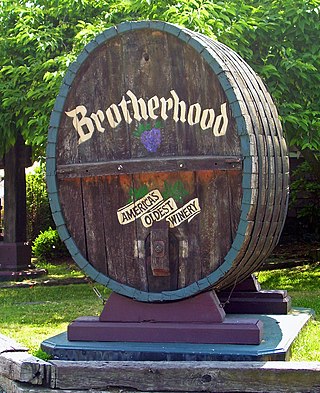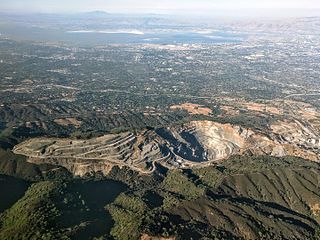
Napa County is a county north of San Pablo Bay located in the northern portion of the U.S. state of California. As of the 2020 census, the population was 138,019. The county seat is the City of Napa. Napa County was one of the original counties of California, created in 1850 at the time of statehood. Parts of the county's territory were given to Lake County in 1861.

Napa is the largest city and county seat of Napa County and a principal city of Wine Country in Northern California, United States. Located in the North Bay region of the Bay Area, the city had a population of 77,480 as of the end of 2021. Napa is a major tourist destination in California, known for its wineries, restaurants, and arts culture.

The Napa River is a river approximately 55 miles (89 km) long in the U.S. state of California. It drains a famous wine-growing region called the Napa Valley, in the mountains north of the San Francisco Bay. Milliken Creek and Mt. Veeder watersheds are a few of its many tributaries. The river mouth is at Vallejo, where the intertidal zone of fresh and salt waters flow into the Carquinez Strait and the San Pablo Bay.

The California Northern Railroad is one of several Class III short-line railroad companies owned by Genesee & Wyoming, Inc. It operates over Southern Pacific Railroad (SP) tracks under a long-term lease.

The Napa Valley Wine Train is a privately operated excursion train that runs between Napa and St. Helena, California. Much of the rail line parallels State Route 29 after leaving the City of Napa and passes the towns of Yountville, Rutherford and Oakville. The route passes by many of the region's vineyards and wineries located in Napa County. The Wine Train is operated by the Napa Valley Railroad.

The Napa River-Napa Creek Flood Protection Project is a Civil Works project of the US Army Corps of Engineers in the city of Napa, California. The Project area includes some 6 miles (10 km) of the Napa River from the Butler Bridge on State Route 29 on the south to Trancas Street on the north. This section is the upper reach of the estuary portion of the Napa River and as such is tidally influenced. The Project also includes improvements to 1 mile (1.6 km) of Napa Creek, the primary tributary to the Napa River. The project is cited as a new way of thinking about flood control due to its "living river" principles.
USS Clamp (ARS-33) was a Diver-class rescue and salvage ship acquired by the U.S. Navy during World War II. Her task was to come to the aid of stricken vessels.

USS Bolster (ARS-38) was a Bolster-class rescue and salvage ship acquired by the U.S. Navy during World War II and remained in service during the Korean War and the Vietnam War. Her task was to come to the aid of stricken vessels.

The San Francisco, Napa and Calistoga Railway, later briefly reorganized as the San Francisco and Napa Valley Railroad, was an electric interurban railroad in the U.S. state of California. In conjunction with the Monticello Steamship Company, the railway offered a combined rail- and ferry-service called the "Napa Valley Route."

The wide variety of wild grapes in North America were eaten by the indigenous people. The first Europeans exploring parts of North America called it Vinland because of the profusion of grape vines found there. The various native grapes had flavors which were unfamiliar to European settlers and did not like using them in the initial production of American wine. This led to repeated efforts to grow familiar Vitis vinifera varieties. The first vines of Vitis vinifera origin came up through New Spain (Mexico) and were planted in Senecu in 1629, which is near the present day town of San Antonio, New Mexico.

The Permanente Quarry and cement plant is in an unincorporated area of Santa Clara County, California, just west of Cupertino. The limestone and aggregate mining operation and cement plant is owned by Lehigh Southwest Cement, a subsidiary of Heidelberg Cement. Limestone was mined beginning in 1902 but remained a small operation until 1939 when it was purchased by Henry J. Kaiser to supply the 5.5 million barrels of cement to build Shasta Dam. With increased production Kaiser supplied all of the cement used by the Navy in the Pacific Theater of World War 2. At 7 million barrels, it was more cement than the Shasta Dam project. Roughly 70 percent of the cement used in the communities of Santa Clara County was acquired from the cement plant.

G. L. Mezzetta, Inc., commonly known as Mezzetta, is a California food processor that packs olives, pickled peppers and other pickled vegetables in glass jars for retail sale. They also pack and sell wine-based pasta sauces under the Napa Valley Bistro brand name.

American Canyon High School is a public comprehensive high school located in American Canyon, California. It is operated by the Napa Valley Unified School District.

Lake Hennessey is a reservoir in the Vaca Mountains, east of St. Helena and the Napa Valley, within Napa County, California.
Cuttings Wharf is an unincorporated community in Napa County, California. It lies at an elevation of 7 feet. Cuttings Wharf is located on the Napa River, 4 miles (6.4 km) northwest of Napa Junction.
Shipyard Acres was an unincorporated community in Napa County, California. It lies at an elevation of 33 feet. Shipyard Acres is located 2.5 miles (4.0 km) south-southeast of Napa.
The Veterans Home of California is located in Yountville, California, and was founded in 1884. The facility is the largest of its kind in the United States and has a population of almost 800 aged and disabled veterans of World War II, the Korean War, the Vietnam War, the Gulf War, the War in Afghanistan, and Operation Enduring Freedom/Operation Iraqi Freedom. Several levels of care are offered to residents, including domiciliary services, residential care for the elderly, intermediate nursing care, skilled nursing care, and outpatient clinic.
John Patchett (1797–1876) was the first person to plant a commercial vineyard and build a commercial wine cellar in the Napa Valley in California. Patchett planted his vineyard in 1854 and started making wine in 1857. Patchett established his winery in Napa in 1858.

Charles Krug (1825–1892) was among the pioneers of winemaking in the Napa Valley, California, and was the founder of the Charles Krug Winery.

The 2014 South Napa earthquake occurred in the northern San Francisco Bay Area on August 24 at . At 6.0 on the moment magnitude scale and with a maximum Mercalli intensity of VIII (Severe), the event was the largest in the San Francisco Bay Area since the 1989 Loma Prieta earthquake. The epicenter of the earthquake was located to the south of Napa and to the northwest of American Canyon on the West Napa Fault.















